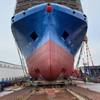German shipping company Hamburg Süd raised its revenue last year due to the acquisition of Chilean line Compañía Chilena de Navegación Interoceánica (CCNI), yet the container business still performed weaker than expected.
The company reported an increase in total turnover by 16.8 percent to EUR 6.05 billion (USD 6.8bn).
Shipment volume in the liner business rose on the previous year by 21.5 percent to 4,101 million TEU.
Despite the weakness of the South American economies (especially Brazil, Argentina, and Venezuela), this made it possible to meet the volume growth planned for the reporting year. A fleet capacity of 625,000 TEU (+16 percent year on year) propelled the Hamburg Süd Group into the ranks of the ten largest container shipping lines worldwide for the first time.
Due to global overcapacity, freight rates declined by roughly 16 percent. The resulting loss of revenue could only partially be offset in the liner division by falling fuel prices, and restrictive capacity and cost management. The result in this sector failed to meet expectations and must be described as less than satisfactory.
Bulk shipping was also characterized by very difficult market conditions. Due chiefly to China’s lower raw material imports, demand for shipping space remained static while global fleet growth rose once again on the previous year.
As a result, the revenue generated fell sharply. Bulk shipping fell well short of the result planned for the reporting period. Only the product tanker segment achieved a satisfactory result. Capital spending totaled 437 million euros, putting it above the level of the previous year. The number of employees increased to 5,960 on an annual average due to growth.
Following the significant growth of shipment volume in liner shipping in the past fiscal year, Hamburg Süd anticipates a further significant, albeit more moderate increase in carryings of some 8 percent for 2016 compared to the previous year.
The once again above-average increase in excess of market growth is based primarily on the capacities and market shares built up in the past fiscal year, which are to be maintained throughout 2016 and selectively further expanded. Because freight rates are expected to remain under pressure due to continuing overcapacities and weak economic development, it is anticipated that the shipping group’s turnover will stay roughly the same.










